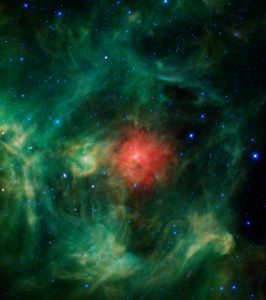Una ghirlanda in cielo

La missione della NASA Wide-field Infrared Survey Explorer (WISE) presenta la “Nebulosa Ghirlanda”. Anche se non si tratta del nome ufficiale della nebulosa (in realtà si chiama Barnard 3 o IRAS G159.6-18.5), è facile immaginare una ghirlanda festosa in queste brillanti nubi polverose verdi e rosse. Nubi interstellari come queste sono vivai stellari, luoghi in cui nascono le stelle.
L’anello verde è composto da minuscole particelle di polvere calda. La nube rossa è costituita da polvere più metallica e più fredda rispetto alle regioni circostanti. La stella brillante al centro della nube rossa, chiamata HD 278942, è così luminosa da essere probabilmente la causa del bagliore nella maggior parte della nube che la circonda. In realtà i suoi potenti venti stellari hanno scavato la polvere calda circostante e hanno creato la struttura a forma di anello. La brillante regione giallo-verdastra a sinistra del centro è simile all’anello, anche se più densa. Le stelle bianco-azzurre sparse nell’immagine sono situate sia davanti che alle spalle della nebulosa.
La ghirlanda si trova tra la costellazione di Perseo e quella del Toro, ad una distanza di circa 1.000 anni luce dalla Terra.
I colori utilizzati in questa immagine rappresentano specifiche lunghezze d’onda della luce infrarossa. Blu e ciano rappresentano la luce a 3,4 e 4,6 micron, proveniente in prevalenza dalle stelle. Verde e rosso rappresentano la luce a 12 e 22 micron, rispettivamente, emessa per lo più dalla polvere.
[ Barbara Bubbi ]
http://wise.ssl.berkeley.edu/gallery_Barnard3.html
Credit: NASA/JPL-Caltech/WISE Team
Lascia un commento